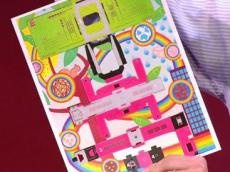|
|
TODAY.AZ / Weird / Interesting
Cheapest microscope has ever been seen
13 March 2014 [13:05] - TODAY.AZ
 A low-cost microscope made from folded paper and a cheap lens could revolutionize education and health care in the developing world.
A low-cost microscope made from folded paper and a cheap lens could revolutionize education and health care in the developing world.Origami, the Japanese art of paper folding, has evolved considerably since it appeared in the western world over a century ago. Folding is simple, easy and cheap. So it’s no wonder that scientists and engineers have begun to exploit it in all kinds of innovative ways. They now use origami to construct everything from molecular machines to space telescopes.
Today, Manu Prakash and pals at Stanford University in California, reveal how they’ve designed and built an origami microscope that is constructed largely out of folded paper and costs less than a dollar to make. And they say their device could revolutionize the way billions of people see the world around them.
Prakash and co call their device the Foldscope and say it can be assembled from a flat sheet of paper in under 10 minutes.
As well as the paper structure, the device also requires a tiny lens (cost $0.56), and to provide light, a 3V button battery (cost $0.06), an LED ($0.21) plus a couple of other bits and pieces, such as tape and a switch. The total cost is $0.97, say Prakash and co.
The device is simple to operate. Simply place your eye close enough to the lens that your eyebrow touches the paper and then focus and pan using your thumbs to manipulate the position of the lens and its distance to the subject.
And the results are impressive. Prakash and co show how to use the device in a number of different configurations to achieve brightfield and darkfield images as well as fluorescence microscopy.
That has important applications. One obvious use is in education, where such cheap devices could bring microscopy to the masses.
But equally important are applications in healthcare where foldable microscopes could be made disease specific with the right kind of staining and filters. Prakash and co have already shown how their device can image common bacteria and parasites such as Giardia lamblia, Leishmania donovani, Trypanosoma cruzi (Chagas parasite), Escherichia coli and so on.
And at a dollar a throw, these microscopes could be made disposable to reduce cross contamination and the possibility of infection from highly contagious diseases.
These guys have big plans for the future. They say that modern manufacturing techniques would allow the production of these devices on a huge scale. “Roll-to-roll processing of flat components and automated “print-and-fold” assembly make yearly outputs of a billion units attainable,” they say.
URL: http://www.today.az/news/interesting/131781.html
 Print version
Print version
Views: 2591
Connect with us. Get latest news and updates.
See Also
- 19 February 2025 [22:20]
Visa and Mastercard can return to Russia, but with restrictions - 05 February 2025 [19:41]
Japan plans to negotiate with Trump to increase LNG imports from United States - 23 January 2025 [23:20]
Dubai once again named cleanest city in the world - 06 December 2024 [22:20]
Are scented candles harmful to health? - 23 November 2024 [14:11]
Magnitude 4.5 earthquake hits Azerbaijan's Lachin - 20 November 2024 [23:30]
Launch vehicle with prototype of Starship made its sixth test flight - 27 October 2024 [09:00]
Fuel prices expected to rise in Sweden - 24 October 2024 [19:14]
Turkiye strikes terror targets in Iraq and Syria - 23 October 2024 [23:46]
Kazakhstan supplied almost entire volume of oil planned for 2024 to Germany in 9 months - 23 October 2024 [22:17]
Taiwan reported passage of Chinese Navy aircraft carrier near island
Most Popular
 Road exchange and its subtleties for Baku and Yerevan
Road exchange and its subtleties for Baku and Yerevan
 Crime without statute of limitations: five years since tragedy of Barda
Crime without statute of limitations: five years since tragedy of Barda
 Pakistan closes airspace along border amid India’s large-scale military drills
Pakistan closes airspace along border amid India’s large-scale military drills
 President Ilham Aliyev visits cotton processing plant in Sabirabad Industrial Park
President Ilham Aliyev visits cotton processing plant in Sabirabad Industrial Park
 Azerbaijani Foreign Minister meets Omani counterpart to boost bilateral cooperation
Azerbaijani Foreign Minister meets Omani counterpart to boost bilateral cooperation
 World Bank urges Azerbaijan to accelerate reforms to attract private investment
World Bank urges Azerbaijan to accelerate reforms to attract private investment
 Zelensky: Work on plan for ceasefire in next ten days
Zelensky: Work on plan for ceasefire in next ten days
